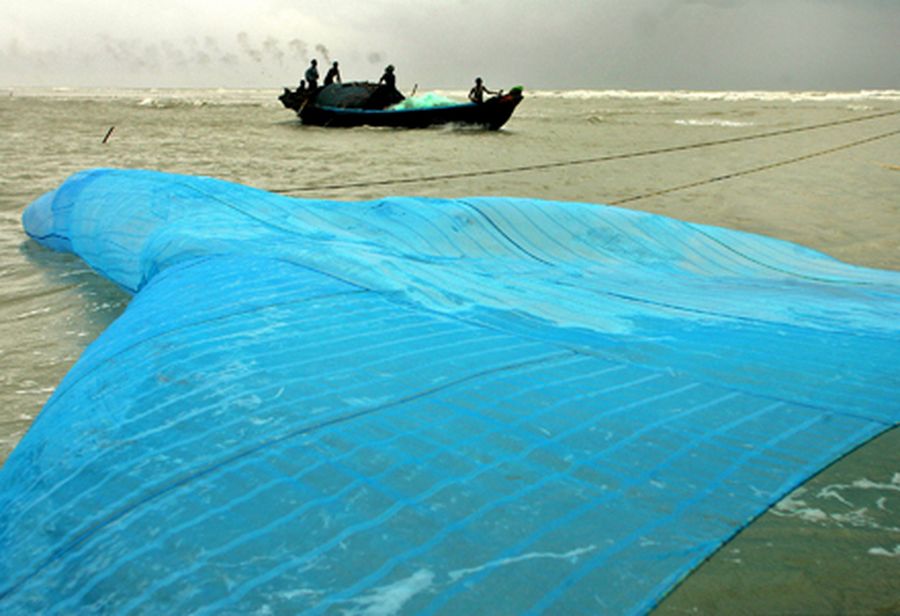India’s financial institutions returned to the international bond market this summer with a flurry of well-received fundraisings. ICICI Bank, India’s biggest international borrower pre-crisis, dodged fears of a sovereign downgrade to remain the sector’s benchmark.

Source: Reuters/Jayanta Shaw
An Indian fishing boat crosses behind a giant fishing net in the backdrop of monsoon rain clouds at Sagar Island.
As Indian issuers rethink their approach to the international capital markets, ICICI Bank is at the forefront of a changing mindset. India’s largest private-sector bank has shown an increasing willingness to look beyond traditional financing avenues and explore less-conventional markets.
In doing so, it has maintained its good reputation among investors and completed its recovery from the bad loans that came with the 2008 financial crisis.
The bank’s most recent capital markets foray was its three-year Dim Sum bond, launched last month. The Rmb500m (US$80m) deal was ICICI’s second in the offshore renminbi market, but was notable because, this time, it came with a bookbuilding process – unlike the first one.
Building on its Dim Sum debut of Rmb210m due March 2015, which was also the first offshore renminbi bond from the branch of an Indian bank, the new Rmb500m issue attracted an enormous order book and was 8x covered.
The deal illustrated just how tuned to the market ICICI was, with the timing of an opportunistic tap in a market that was rallying on the back of the third round of US quantitative easing.
The deal helped the bank diversify its funding sources away from dollar investors, while the cross-currency swap allowed it to achieve handsome savings vis-à-vis issuing in the dollar bond market.
Bankers on the deal said that the issuer had been closely monitoring the market and saw that, even though its outstanding dollar bond maturing in 2018 was performing well in the secondary market, the short end of the dollar curve was still wider, and could be beaten in a different currency.
The Dim Sum bond was priced at 4.9%, tighter than the initial talk of 5.1%, as investors rushed to book a rare offering of Indian bank paper at a relatively high yield. After swaps, the Dim Sum pricing translated to around 242.5bp over Libor, assuming mid-swaps.
That was 40bp–50bp cheaper than its US-dollar funding cost.
Given the savings the bank achieved in tapping the Dim Sum market, there is talk that the issuer may also look to tap the Singapore dollar market.
“Asian local currencies are providing a very legitimate and viable alternative for Indian issuers because of investors’ proximity and awareness about them. We have seen three Indian entities issue in the Singapore-dollar market. Other Indian firms can also issue in Singapore dollars if they seize the right window,” said Jujhar Singh, managing director and head of DCM South Asia at Standard Chartered.
HSBC and StanChart ran ICICI’s Rmb500m Dim Sum bond, while Bank of America Merrill Lynch, Citigroup, HSBC, JP Morgan and StanChart led its US$750m 5.5-year global bond a month earlier.
ICICI remains the benchmark name for dollar bonds among private Indian banks and again demonstrated the power of its presence in the dollar market.
The US$750m 5.5-year bond in August priced 12bp inside its implied curve, and received an overwhelming US$5.7bn of orders.
There was a roadshow for the dollar issue, but ICICI’s regular updating of its investors about its financial performance allowed for lightening-quick execution.
“ICICI has shown a lot of discipline in sizing issues according to funding requirements and has had market-savvy in establishing new benchmarks, like in CNH. It is also commendable that it has engaged with investors regularly over the last year and a half, updating investors on the bank’s performance, even when not planning a deal, which paid off when it was in the market looking to price one,” Singh said.
These successful issues are part of the bank’s recovery story as it has managed to reduce its bad loans to 3.5% of total assets, from 5% in the year to March 2010.
Bankers said this improved credit quality and the maturity of the 6.625% bond are helping the new 5.5-year bond trade at record tights to government-run rival State Bank of India.
At the time of writing, SBI 2017s were trading around Treasuries plus 286bp, and ICICI 2018s were around Treasuries plus 312bp, giving a differential of only 16bp once the curve is factored in.
ICICI’s ability to access dollar funding has helped restore confidence in its credit default swaps, which have come in 100bp since the August issue. The five-year senior CDS was last quoted at 280bp, a dramatic improvement from this year’s high print of 467bp when fears for India’s economy were at a peak at the start of June.
With its strong record and good reputation with investors, other Asian currencies are open to ICICI. It would not be a completely new name in the Sing-dollar market, having completed some private placements in the past, but successful deals from Indian Oil Corp and IDBI Bank suggest it ill be capable of something far larger.
In April last year, it sold a S$60m (US$48m) five-year bond at 3.80% and before that it raised S$35m through a one-year bond at 1.5125%.
Bankers said these small private placements would help ICICI attract investors if it decided to issue again in Sing dollars.
To see the digital version of this report, please click here.
